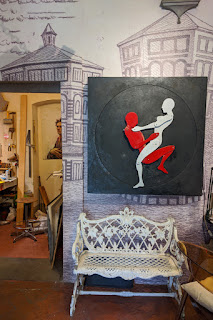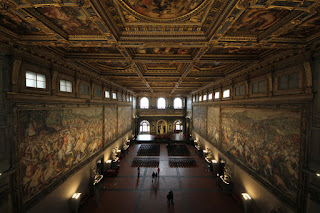Good morning! We were up a little earlier than yesterday. It took me a while to get going because my foot was very stiff. Some ibuprofen and espresso later, we walked to the Bargello Museum a few minutes before they opened. The building has an unfortunate history. It had been a place of justice until 1574 when it became a prison that was notorious for squalor, torture, and executions. The prison was closed in 1859 and a restoration job began within the next ten years. Today it exists as a really wonderful art museum that is open only five hours a day.
Bust of Brutus, Michelangelo
This chapel was at one point whitewashed and sub-divided into numerous jail cells.
The frescoes in the chapel are attributed to the School of Giotto
This room contains many important sculptures
Donatello's St. George once adorned the Orsanmichele building in Florence. He originally held a real sword and wore a helmet. Those items rusted away over the years but now a copy of the statue stands inside the building's niche. This figure is interesting because rather than creating a burly warrior this St. George has an everyman look and somewhat weak chin.
Donatello's bronze David. Cosimo de' Medici comissioned this work (probably.
It was the first life-size nude sculpture produced since ancient Roman times.
It was also one of the first works of art for art's sake.
Donatello's marble David. This was one of the artist's first important commissions. It was supposed to adorn the Duomo but its scale was too small to be visible from the ground. After being asked to make a few modifications to the work, Donatello's sculpture was passed around by museums throughout the city until it was finally put on display at the Bargello.
Two of my favorite items at the museum: Ghiberti and Brunelleschi's original Baptistery door competition entries (respectively). Artisans were asked to portray the sacrifice of Isaac in bronze within a quatrefoil frame.
After leaving the museum we walked east and crossed over the Arno. One big hill and cardio workout later, we landed on the steps of San Miniato al Monte, an ornate basilica that sits at the top of one of the highest points in Florence. The author of Pinocchio is buried in the church cemetery.
A short walk below our hill was the Piazzale Michelangeo, a popular scenic spot.
*huff, puff*
Ponte Vecchio
From here we could see a little of the famed Boboli Gardens
As we made our way back to the center of town we stopped at the studio of resident artist Clet Abraham. He is known all over the world for his street art. The studio is open to the public and has a neat little gift shop. His "clock" is very unique :)
We went back to the sandwich shop from Sunday night and ate while overlooking the river. My art history book specifically does not cover any of the paintings inside Palazzo Vecchio because most of them are self-serving Medici propaganda and not very skillful in execution.
Main courtyard with copy of "Putto with Dophin".
The original sits inside a random interior corridor.
Nearly all of the rooms of the palace were empty save ornate ceilings such as this.
The main hall was quite impressive.
By the time that the Medicis were in full autocrat mode in the 1500s they had crown jewels made for themselves. It was a bit self-aggrandizing for a Duke.
Map room. The map of Algeria in the corner hid a door
that leads to one of the palace's many secret passages.
Back out on the streets again we decided to visit the inside of the Duomo again. While I was taking pictures outside there was no line but all of a sudden a school group of about 100 teenagers showed up!
Instead of waiting for the crowd we used our entrance ticket to visit the headquarters of the Compagnia della Misericordia (Company of Mercy), one of the oldest charities in the world. Established in 1244, its purpose was to provide ambulance transport (today a fleet of modern ambulance vehicles sit in the Duomo piazza), pauper burials, and medical care for impoverished citizens. Members and volunteers wore hooded robes in the execution of their duties because it was believed that charitable work should be done anonymously (and not for boosting PR). The charity is so well-known that over the centuries hundreds of artists have donated paintings and other works. As a result the organization has a small museum that includes pieces that have been shown around the world.
Volunteers working in front of the Baptistery
Inside the cathedral later (and without school groups) we entered the crypts, which follow much of the 3rd century church floor plan. Many wonderful mosaics are visible today. Brunelleschi's tomb is sadly behind the gift shop but at least it's closed off from the crowds by a wall and iron gate.
Model showing overlay of original church and current building.
Piazza della Signoria
Palazzo Vecchio exterior
External of Orsanmichele with copy of Donatello's St. George
After all of the sightseeing it was time for a break in the hotel room. We enjoyed watching Italy's equivalent to what America's Bravo channel use to be: 24 hours of performing arts documentaries and concerts.
After sunset we walked for about 30 minutes to a local favorite restaurant for dinner: Il Guscio. I had a massive platter of cured meats and suckling pig. Hans had a nice sea bass pasta, followed by a plate of stewed boar with olives and artichokes. Our server gave a couple of great wine recommendations and we left the restaurant feeling pretty full but happy. It was a beautiful last evening in Florence.















































No comments:
Post a Comment